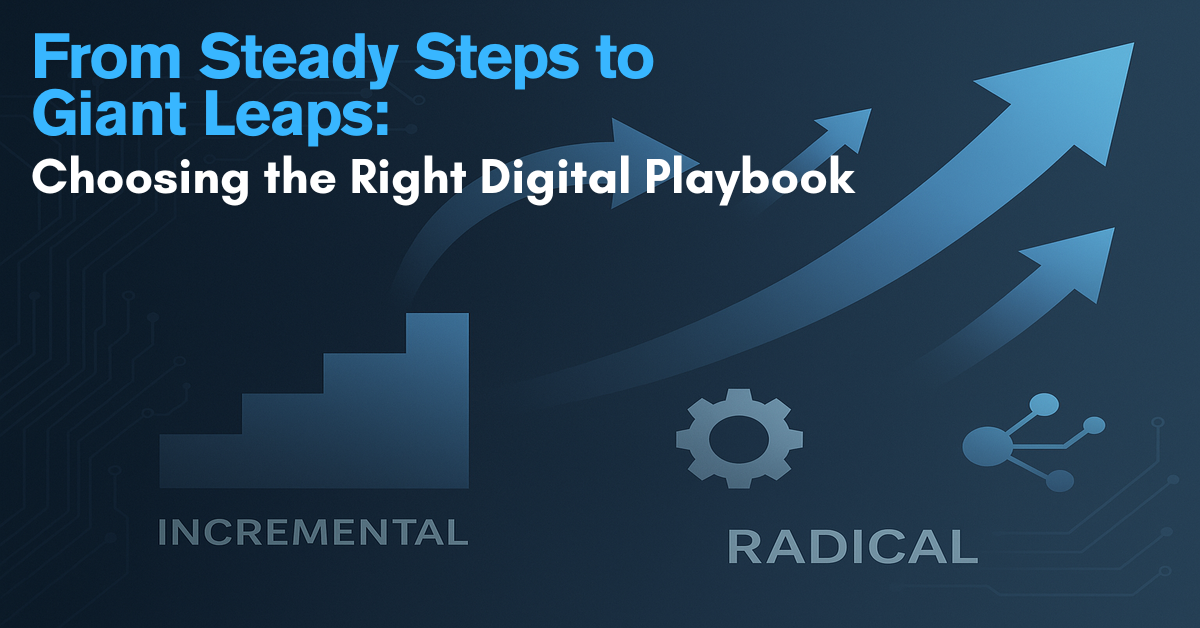In today’s business world, digital transformation isn’t a choice—it’s essential. Leaders regularly face a tough decision: Should digital change be radical and disruptive, or incremental and adaptive? Recent research from ScienceDirect and Harvard Business Review (HBR) shows different paths companies can follow, each deeply influencing performance, resilience, and competitive advantage.
The Digital Dilemma
Markets today are marked by continuous disruption. Deciding between radical or incremental digital transformation shapes market positioning, resource allocation, and success. Radical digital strategies promise big leaps forward, while incremental changes offer stability and lower risk.
A study in Expert Systems with Applications highlights radical digital transformation, characterized by significant tech shifts, delivering rapid competitive advantages. Harvard Business Review, meanwhile, argues incremental, less-disruptive methods can also deliver meaningful results by aligning closely with existing organizational strengths and culture.
Radical Digital Transformation: Big Rewards, Big Risks
Radical transformation means large-scale tech, process, and cultural shifts. This approach comes with high risks and heavy investments but can disrupt industries dramatically.
The ScienceDirect research emphasizes how radical innovations driven by strong tech frameworks and AI systems significantly boost competitive standing. Companies like Tesla and Airbnb exemplify this approach, reshaping industries quickly and achieving market leadership.
Yet radical strategies demand big upfront investments in technology, talent, and infrastructure. Abandoning legacy systems and overcoming cultural resistance are significant challenges leaders must navigate.
Incremental Digital Transformation: Evolving with Stability
Conversely, HBR suggests a more balanced approach, stating digital change doesn’t need to be abrupt to deliver results. Incremental transformation involves gradual tech integration, leveraging existing strengths, and adapting slowly to organizational readiness.
Companies like Walmart and Unilever have shown how step-by-step digital integration enhances operational efficiency, deepens customer relationships, and boosts profitability steadily. This method faces less internal resistance, allowing for smoother acceptance and operational continuity.
Creating a Digital Mindset and Culture Across All Levels
Regardless of strategy, success in digital transformation hinges on creating a digital mindset and culture among employees at every level. Employees must feel confident owning digital initiatives, rather than assuming this responsibility belongs solely to the digital team.
A pervasive digital mindset empowers employees to identify opportunities and suggest innovations independently. Companies like Adobe and Microsoft emphasize digital literacy training and clear communication on digital goals, ensuring all staff feel involved and accountable. This cultural shift can make or break digital transformation initiatives, fostering genuine ownership and proactive participation.
You don’t have to go it alone.
Become part of our exclusive community of C-suite leaders who are redefining digital transformation—sharing best practices, case studies, and peer insights every month.
Choosing the Right Digital Path
Deciding between radical and incremental digital strategies should align clearly with strategic goals, company culture, industry dynamics, and market position.
- Clear Objectives: Companies need explicit digital goals—whether rapid disruption or steady evolution.
- Risk Appetite: Radical transformations demand higher risk tolerance. Incremental strategies offer lower risks and more predictable outcomes.
- Cultural Readiness: Assess internal readiness honestly. Agile cultures handle radical change better, while stability-focused cultures prefer incremental shifts.
- Industry Conditions: Radical approaches suit highly dynamic, competitive sectors. Incremental strategies fit stable or regulated industries.
Hybrid Approach: A Balanced Path
A growing trend is hybrid transformation, blending radical and incremental approaches. Companies like Microsoft and Adobe demonstrate this balance, using radical innovations selectively while maintaining incremental improvements broadly.
This strategy allows companies to seize high-impact opportunities without risking overall stability. It aligns innovation with operational excellence, balancing risk and reward effectively.
Action Steps for Leaders
For effective, high-impact digital transformation, leaders should:
- Set Clear Goals: Define clear outcomes from digital transformation.
- Assess Readiness: Evaluate culture, tech capability, and resources thoroughly.
- Define Metrics: Establish clear success metrics for radical or incremental initiatives.
- Foster Continuous Learning: Promote a culture of ongoing learning and adaptability.
- Balance Innovation and Stability: Implement hybrid approaches strategically, balancing risk and rewards.
Crafting Your Digital Future
There is no universal solution for digital transformation. Whether choosing radical disruption, incremental evolution, or a balanced hybrid, leaders must align digital initiatives with strategic clarity, culture, and market dynamics.
Digital transformation demands agile leadership, balancing innovation with practicality. Choosing your strategy defines your competitive future. CEOs and executives seeking strategic clarity on executing impactful digital transformations are encouraged to initiate exploratory conversations.
Your digital future depends not just on technology choices but on the right strategic approach. Radical, incremental, or hybrid—your choice will determine your digital destiny.
References
Christensen, C. M., Dillon, K., Duncan, D. S., & Hall, T. (2019). Digital doesn’t have to be disruptive. Harvard Business Review. Retrieved from https://hbr.org/2019/07/digital-doesnt-have-to-be-disruptive
Yu, D., & Hang, C. C. (2010). A reflective review of disruptive innovation theory. Expert Systems with Applications, 37(12), 8208-8215. https://doi.org/10.1016/j.eswa.2010.05.017
About Catallyst Insights
Catallyst Insights is your essential executive briefing, delivering data-backed analysis and actionable strategies on digital transformation, AI integration, and leadership excellence. Each issue equips C-suite leaders with the insights they need to drive innovation, optimize performance, and stay ahead in today’s fast-moving digital landscape. We’re proud to bring you the latest findings from global research—because it’s our obligation to help you remain ahead of the curve.

